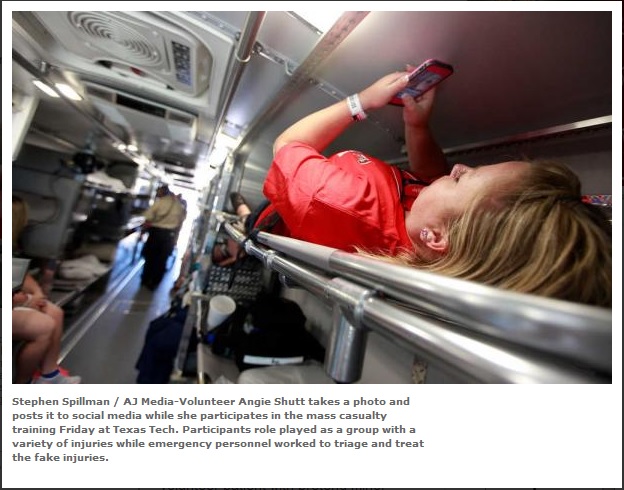First responders prepare for when, not if – Emergency personnel practice dealing with disasters
By JENNIFER LOESCH
A-J MEDIA
The state of Texas launched the Texas Emergency Medical Task Force about two years ago to help emergency personnel deal with medical emergencies that result from any situation across the state.
On Friday, June 7, members of the task force and volunteer patients practiced for a real emergency on a parking lot at Texas Tech.
“You’ve got to be ready for anything these days,” said D’aun Green, a volunteer patient with pretend minor lacerations.
Green is the senior associate managing director for student housing at Tech, and attending the training gave her the opportunity to see how a real situation might be handled.
Texas Emergency Medical Task Force Region 1 Coordinator Rodney Hunt said the footprint that has been created outlines a plan to protect Texas medically in case of large casualties or disasters, such as the recent explosion in West, where a unit was deployed.
“Texas has always been very aggressive when it comes to taking care of its people,” Hunt said.
Each unit consists of four components: 25 ambulances, one mobile medical unit, two ambulance bus teams and 25 registered nurses. At Friday’s training, Hunt said only half of the region’s equipment was on hand; the other “setup” was in Amarillo, where it is stored.
Each mobile medical unit has 16 beds plus space for a couple more beds in the emergency room area of the unit, Hunt said. The mobile medical unit is a large tent with rooms designated for different purposes.
The mobile medical unit is self-contained with a full bathroom, small kitchenette, communications room and air conditioning run by two generators. The unit has portable hand-washing sinks and the trailer has a 500-gallon water tank.
When the entire state’s mobile medical units are combined, it makes a 136-bed hospital, which would cover an entire football field, Hunt said.
Volunteer patients, like Archie Westbrook, wore badges around their necks to let paramedics know what their injuries were. His badges designated he had abdominal evisceration.
Westbrook has a bachelor’s degree in nursing from Tech, but he is earning additional accreditation. He would like to one day be part of the team.
After the patients were triaged, they were loaded onto UMC’s 20-patient ambulance bus, which is licensed as a mobile intensive care unit, Hunt said. The bus is operated by a special team from UMC, which includes a skilled set of paramedics.
“They’re a select group of paramedics and this is true for all the am-buses, ’cause they’re all top-notch medics,” Hunt said. “It’s that way across the state. We want the best.”
Paramedics really need to be good critical thinkers, be able to conduct quick assessments and make appropriate care decisions, Hunt said.
The bus can be used to transport or evacuate adults, wheelchair users and even neonatal units such as a situation in El Paso required, Hunt said. The incubators were bolted to the bus’s floor and there was still room for nurses.
UMC EMS Division Chief Tim Berry said it takes his people about 15-20 minutes to mobilize. During the Wednesday, June 5, storm his group was prepared to assist people displaced at a local motel but the request was canceled before they arrived.
“We’ve been on standby to go to Oklahoma two times,” Berry said, referring to the tornado-ravaged Oklahoma City metro area.
UMC’s ambulance bus was utilized during the sandstorm at New Deal last winter.
Hunt said what’s so nice about the project is its versatility and flexibility. The project can be used at disaster sites and also at festivals or marathons where large numbers of people are likely to need medical attention.
These kinds of tactics take some of the burdens off emergency rooms that might not be able to accommodate large numbers of patients. People who don’t need extensive medical care can be treated and released from the mobile medical unit.
It takes 48 hours to mobilize FEMA, but it takes Hunt’s group three hours to mobilize for any event in the state. Seventy team members are set up to receive text messages telling them to mobilize, but only 14 are needed to work a 12-hour shift.
“The idea behind it is, Texas will take care of Texas before we call in federal assets, so we’d already be in the fight,” Hunt said.
jennifer.loesch@morris.com
• 766-2159
Follow Jennifer on Twitter @ the_scoop78

